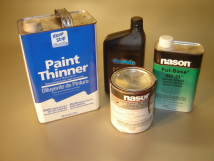
Title: Types of Hazards in the Shop
Description: A great deal of research has been done on the various environmental factors related to safety in the workplace. These factors can cause sickness, impaired health and significant discomfort to technicians, and even death in some cases. When working in an automotive shop, the most common environmental hazards include chemical, physical, and ergonomic hazards.
Chemical hazards arise from high concentrations of air-borne mist, vapors, gases, liquids, or solids in the form of dust or fumes. Chemically hazards include:
Engine oils Gasoline
Solvents Transmission fluids
Transaxle fluids Differential fluids
Engine coolant (antifreeze) Air-conditioning refrigerants
Batteries (lead, sulfuric acid) Tires
Belts Cleaning fluids and chemicals
Brake fluids Paints
Asbestos brake linings Greases
Transmission clutch plates
Physical hazards arise from excessive levels of noise, vibration, temperature, and pressure. There are also cutting and crushing hazards in the shop. Examples include stamping, grinding, exhaust heat, coolant-system pressures, and electrical shock.
Ergonomics is the study of human characteristics for the appropriate design of living and working environments. Ergonomic hazards are defined as conditions that relate to the position or proper function of one’s body to motion. They include such examples as poorly designed tools or work areas, improper lifting or reaching, poor lighting and so on.
Back to Safety
Description: A great deal of research has been done on the various environmental factors related to safety in the workplace. These factors can cause sickness, impaired health and significant discomfort to technicians, and even death in some cases. When working in an automotive shop, the most common environmental hazards include chemical, physical, and ergonomic hazards.
Chemical hazards arise from high concentrations of air-borne mist, vapors, gases, liquids, or solids in the form of dust or fumes. Chemically hazards include:
Engine oils Gasoline
Solvents Transmission fluids
Transaxle fluids Differential fluids
Engine coolant (antifreeze) Air-conditioning refrigerants
Batteries (lead, sulfuric acid) Tires
Belts Cleaning fluids and chemicals
Brake fluids Paints
Asbestos brake linings Greases
Transmission clutch plates
Physical hazards arise from excessive levels of noise, vibration, temperature, and pressure. There are also cutting and crushing hazards in the shop. Examples include stamping, grinding, exhaust heat, coolant-system pressures, and electrical shock.
Ergonomics is the study of human characteristics for the appropriate design of living and working environments. Ergonomic hazards are defined as conditions that relate to the position or proper function of one’s body to motion. They include such examples as poorly designed tools or work areas, improper lifting or reaching, poor lighting and so on.
Back to Safety